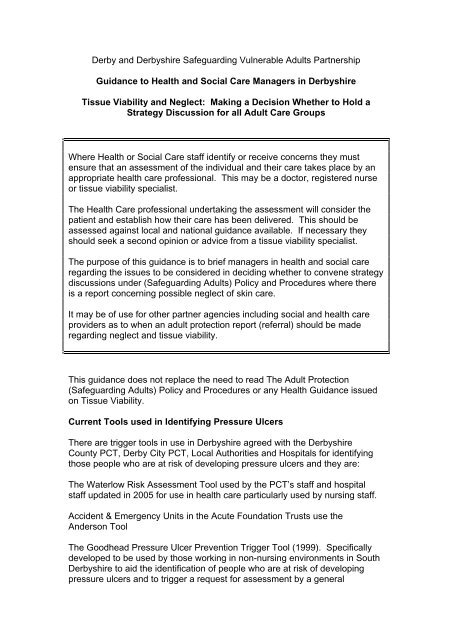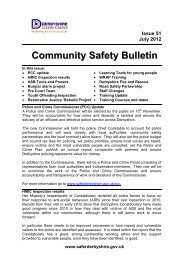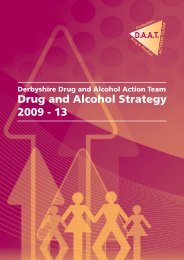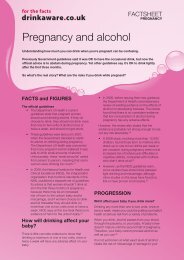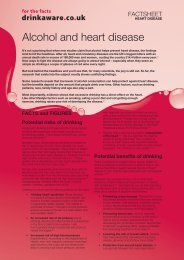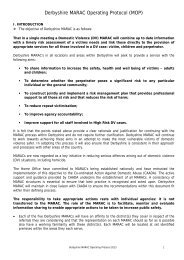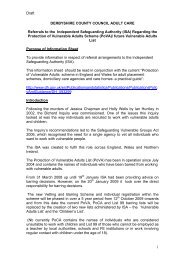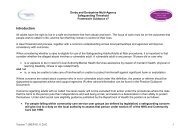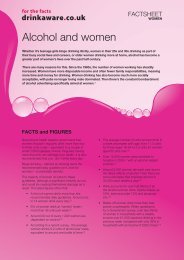Guidance on Tissue Viability and Safeguarding - Safer Derbyshire
Guidance on Tissue Viability and Safeguarding - Safer Derbyshire
Guidance on Tissue Viability and Safeguarding - Safer Derbyshire
You also want an ePaper? Increase the reach of your titles
YUMPU automatically turns print PDFs into web optimized ePapers that Google loves.
Derby <strong>and</strong> <strong>Derbyshire</strong> <strong>Safeguarding</strong> Vulnerable Adults Partnership<br />
<str<strong>on</strong>g>Guidance</str<strong>on</strong>g> to Health <strong>and</strong> Social Care Managers in <strong>Derbyshire</strong><br />
<strong>Tissue</strong> <strong>Viability</strong> <strong>and</strong> Neglect: Making a Decisi<strong>on</strong> Whether to Hold a<br />
Strategy Discussi<strong>on</strong> for all Adult Care Groups<br />
Where Health or Social Care staff identify or receive c<strong>on</strong>cerns they must<br />
ensure that an assessment of the individual <strong>and</strong> their care takes place by an<br />
appropriate health care professi<strong>on</strong>al. This may be a doctor, registered nurse<br />
or tissue viability specialist.<br />
The Health Care professi<strong>on</strong>al undertaking the assessment will c<strong>on</strong>sider the<br />
patient <strong>and</strong> establish how their care has been delivered. This should be<br />
assessed against local <strong>and</strong> nati<strong>on</strong>al guidance available. If necessary they<br />
should seek a sec<strong>on</strong>d opini<strong>on</strong> or advice from a tissue viability specialist.<br />
The purpose of this guidance is to brief managers in health <strong>and</strong> social care<br />
regarding the issues to be c<strong>on</strong>sidered in deciding whether to c<strong>on</strong>vene strategy<br />
discussi<strong>on</strong>s under (<strong>Safeguarding</strong> Adults) Policy <strong>and</strong> Procedures where there<br />
is a report c<strong>on</strong>cerning possible neglect of skin care.<br />
It may be of use for other partner agencies including social <strong>and</strong> health care<br />
providers as to when an adult protecti<strong>on</strong> report (referral) should be made<br />
regarding neglect <strong>and</strong> tissue viability.<br />
This guidance does not replace the need to read The Adult Protecti<strong>on</strong><br />
(<strong>Safeguarding</strong> Adults) Policy <strong>and</strong> Procedures or any Health <str<strong>on</strong>g>Guidance</str<strong>on</strong>g> issued<br />
<strong>on</strong> <strong>Tissue</strong> <strong>Viability</strong>.<br />
Current Tools used in Identifying Pressure Ulcers<br />
There are trigger tools in use in <strong>Derbyshire</strong> agreed with the <strong>Derbyshire</strong><br />
County PCT, Derby City PCT, Local Authorities <strong>and</strong> Hospitals for identifying<br />
those people who are at risk of developing pressure ulcers <strong>and</strong> they are:<br />
The Waterlow Risk Assessment Tool used by the PCT’s staff <strong>and</strong> hospital<br />
staff updated in 2005 for use in health care particularly used by nursing staff.<br />
Accident & Emergency Units in the Acute Foundati<strong>on</strong> Trusts use the<br />
Anders<strong>on</strong> Tool<br />
The Goodhead Pressure Ulcer Preventi<strong>on</strong> Trigger Tool (1999). Specifically<br />
developed to be used by those working in n<strong>on</strong>-nursing envir<strong>on</strong>ments in South<br />
<strong>Derbyshire</strong> to aid the identificati<strong>on</strong> of people who are at risk of developing<br />
pressure ulcers <strong>and</strong> to trigger a request for assessment by a general
egistered nurse. In late 2006 it was reviewed <strong>and</strong> adapted for use by<br />
<strong>Derbyshire</strong> County Council <strong>and</strong> <strong>Derbyshire</strong> County Primary Care Trust as part<br />
of a multi-agency approach to reducing the risk of pressure damage to people<br />
living in their own homes <strong>and</strong> care homes.<br />
References:<br />
• Nati<strong>on</strong>al Institute for Health <strong>and</strong> Clinical Excellence <str<strong>on</strong>g>Guidance</str<strong>on</strong>g> for the<br />
preventi<strong>on</strong> <strong>and</strong> Treatment of Pressure Ulcers September 2005<br />
(Appendices)<br />
• Essence of care service user focused Benchmarks for clinical governance<br />
April 2003, Department of Health
Recommended Practice<br />
Step 1<br />
Assess if there is a problem<br />
Where tissue viability is a c<strong>on</strong>cern <strong>and</strong> the service users live in their own<br />
home or in a care home, they will first be seen by a carer (formal or informal)<br />
who can refer to a GP or a District Nurse for assessment <strong>and</strong> treatment. The<br />
health community can provide informati<strong>on</strong> to informal carers <strong>on</strong> how to identify<br />
possible skin care problems.<br />
[Ref: NICE guidance 2005]<br />
Hospitals <strong>and</strong> private nursing homes have registered nursing staff in place<br />
with the relevant skills <strong>and</strong> knowledge to undertake assessment of the risk of<br />
pressure ulcer development <strong>and</strong> manage treatment. For care homes with<br />
service users who receive residential care, reports or referrals are made to<br />
registered nurses working in community nursing teams who will undertake<br />
<strong>and</strong> facilitate treatment for service users.<br />
A strategy discussi<strong>on</strong> is required when there is a high risk of serious harm<br />
being caused by acts or omissi<strong>on</strong>s which could have reas<strong>on</strong>ably been<br />
avoided. This applies whether the service user is being treated for a pressure<br />
ulcer or not.<br />
Step 2<br />
In all cases c<strong>on</strong>sider these three questi<strong>on</strong>s:<br />
1. Are there c<strong>on</strong>cerns that all reas<strong>on</strong>able steps have not been<br />
taken to prevent the pressure ulcer?<br />
2. Is the adult vulnerable?<br />
3. Is there evidence of neglect?<br />
1. Are there c<strong>on</strong>cerns that all reas<strong>on</strong>able steps have not been taken to<br />
prevent the pressure ulcer?<br />
If there are c<strong>on</strong>cerns about whether reas<strong>on</strong>able steps to reduce the<br />
risk of pressure ulcers were taken, the care that was given should be<br />
assessed against available local <strong>and</strong> nati<strong>on</strong>al guidance. A sec<strong>on</strong>d<br />
opini<strong>on</strong> should be sought if necessary.<br />
Specialist advice is available from specialist tissue viability nurse<br />
advisors as to sources for seeking sec<strong>on</strong>d opini<strong>on</strong>s <strong>and</strong> evaluating the<br />
informati<strong>on</strong> collected.<br />
2. Is the Adult Vulnerable?
C<strong>on</strong>sider the definiti<strong>on</strong> of vulnerability c<strong>on</strong>tained in the Adult Protecti<strong>on</strong><br />
(<strong>Safeguarding</strong> Adults) Policy <strong>and</strong> Procedures 2007.<br />
A vulnerable adult, for the purpose of these procedures is any pers<strong>on</strong><br />
aged 18 years or over who:-<br />
• Is or appears to be eligible for Local Authority/Mental Health<br />
Services assistance by reas<strong>on</strong> of mental ill health, physical or<br />
learning disability, age or illness;<br />
And<br />
• May be unable to take care of him/herself OR unable to protect<br />
him/herself against significant harm or exploitati<strong>on</strong>.<br />
3. Is There Evidence of Neglect?<br />
Not all pressure ulcers in a vulnerable adult are the result of neglect.<br />
Neglect is the deliberate withholding OR unintenti<strong>on</strong>al failure to provide<br />
appropriate <strong>and</strong> adequate care <strong>and</strong> support, <strong>and</strong> that this has resulted<br />
in, or is highly likely to result in (when c<strong>on</strong>sidering other vulnerable<br />
adults in the same situati<strong>on</strong>), a preventable pressure ulcer.<br />
However the key questi<strong>on</strong>s to ask of an appropriate nurse or doctor<br />
(from whom you are gathering informati<strong>on</strong>) which applies to all settings<br />
are:<br />
• Should the illness, behaviour or disability of the vulnerable adult<br />
have reas<strong>on</strong>ably required the m<strong>on</strong>itoring of skin c<strong>on</strong>diti<strong>on</strong><br />
(where no m<strong>on</strong>itoring has taken place prior to serious pressure<br />
ulcers occurring)?<br />
• If m<strong>on</strong>itoring was then refused by the vulnerable adult/family<br />
was it reas<strong>on</strong>able for advice to be sought? The vulnerable<br />
adult’s c<strong>on</strong>sent to m<strong>on</strong>itoring should always be sought but if the<br />
pers<strong>on</strong> lacks mental capacity to make a decisi<strong>on</strong> regarding this,<br />
then a decisi<strong>on</strong> will need to be taken in their best interests. The<br />
family has no right to refuse m<strong>on</strong>itoring.<br />
• If m<strong>on</strong>itoring agreed, was the frequency of m<strong>on</strong>itoring<br />
appropriate for the c<strong>on</strong>diti<strong>on</strong> as presented at the time?<br />
• Would m<strong>on</strong>itoring have shown changes in the presentati<strong>on</strong> of<br />
the skin (eg persistent change in colour, temperature of skin etc)<br />
that should have triggered the need for interventi<strong>on</strong> or the<br />
seeking of more expert assistance that would have prevented<br />
serious harm or its high likelihood?
• Was the appropriate expert assistance sought? If so did that<br />
result in a care plan/equipment provisi<strong>on</strong> appropriate to address<br />
the pressure care needs of the vulnerable adult? Did the care<br />
plan address the management of risks that should have<br />
reas<strong>on</strong>ably been identified? (eg the high risk of n<strong>on</strong> compliance<br />
by the service user or informal carer?)<br />
• Was the care plan adhered to <strong>and</strong> revised appropriately? Was<br />
the equipment provided in a timely manner <strong>and</strong> used<br />
appropriately?<br />
If the answer to all 3 questi<strong>on</strong>s above is yes:<br />
Then safeguarding adults procedures must be instigated <strong>and</strong> a strategy<br />
discussi<strong>on</strong> must be held.<br />
[Ref: Adult Protecti<strong>on</strong> (<strong>Safeguarding</strong> Adults) Policy <strong>and</strong> Procedures]<br />
Step 3<br />
If a report has been made under the Adult Protecti<strong>on</strong> (<strong>Safeguarding</strong><br />
Adults) Policy <strong>and</strong> Procedures 2007 <strong>and</strong> where it is necessary to hold a<br />
strategy discussi<strong>on</strong> <strong>and</strong> develop a protecti<strong>on</strong> plan:<br />
The strategy discussi<strong>on</strong> <strong>and</strong> development of a protecti<strong>on</strong> plan must include all<br />
agencies agreeing their respective roles <strong>and</strong> resp<strong>on</strong>sibilities. This must be<br />
clearly documented <strong>and</strong> recorded.<br />
Where the abuse/neglect of a vulnerable adult is alleged to have taken place<br />
in Derby or <strong>Derbyshire</strong>, the report will be made to the officer in the Local<br />
Authority or Service Manager in Mental Health Services who is resp<strong>on</strong>sible for<br />
the services provided to the vulnerable adult.<br />
If the alleged abuse/neglect is discovered or suspected it needs to be made<br />
clear that such informati<strong>on</strong> may need to be shared with other agencies <strong>on</strong> a<br />
“need to know” basis. The service user’s c<strong>on</strong>sent to the sharing of<br />
informati<strong>on</strong> should always be sought. In certain circumstances informati<strong>on</strong><br />
about a pers<strong>on</strong> may be disclosed without their c<strong>on</strong>sent. For further guidance<br />
<strong>on</strong> this please refer to the Adult Protecti<strong>on</strong> (<strong>Safeguarding</strong> Adults) Policy <strong>and</strong><br />
Procedures 2007, paragraph 2.2.<br />
Where no officer can be quickly identified then c<strong>on</strong>tact will be made to the<br />
Local Authority by teleph<strong>on</strong>ing Call <strong>Derbyshire</strong> <strong>on</strong> 0845 605 8058 or Derby<br />
Care Line <strong>on</strong> 01332 717777.<br />
If the patient is in the Derby Hospitals NHS Foundati<strong>on</strong> Trust then the report<br />
(referral) should go to the Derby Hospitals NHS Foundati<strong>on</strong> Trust Community<br />
Care Coordinator who will identify the appropriate officer.
If the patient is in the North <strong>Derbyshire</strong> Royal Hospital Foundati<strong>on</strong> NHS Trust<br />
referrals are made to the social services department in the hospital.<br />
Step 4<br />
Agree <strong>and</strong> set timescales within Adult Protecti<strong>on</strong> (<strong>Safeguarding</strong> Adults) Policy<br />
<strong>and</strong> Procedures. All agencies to clearly underst<strong>and</strong> their roles <strong>and</strong><br />
resp<strong>on</strong>sibilities. The roles <strong>and</strong> resp<strong>on</strong>sibilities of all agencies to be recorded<br />
<strong>and</strong> minuted at each stage of the Adult Protecti<strong>on</strong> (<strong>Safeguarding</strong> Adults)<br />
Policy <strong>and</strong> Procedures.<br />
Step 5<br />
The service user’s case to be reviewed within 6 m<strong>on</strong>ths of the Adult<br />
Protecti<strong>on</strong> (<strong>Safeguarding</strong> Adults) Plan being completed <strong>and</strong> thereafter at least<br />
annually OR as appropriate until the closure of the Adult Protecti<strong>on</strong><br />
(<strong>Safeguarding</strong> Adults) Policy <strong>and</strong> Procedures.<br />
June 2007


